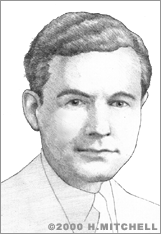Luther Simjian
Luther George Simjian (1905-1997) was a lifelong inventor whose inventions include the self-focusing camera, a flight speed indicator for airplanes, an automatic postage metering machine, and the teleprompter. However, he is perhaps most famous for his invention of the Bankmatic automatic teller machine (ATM).
Simjian was born in Turkey on January 28, 1905. As a young child he developed a keen interest in optics and photography. After World War I he was separated from his family. He fled to Beirut, then on to Marseille, and eventually to the United States. At age 15 he arrived in the U.S. alone, and went to New Haven, Connecticut, where he stayed with relatives and found self-sufficiency through a job with a photographer.
Simjian originally intended to study medicine, but changed his mind after the medical school at Yale gave him a job in its photographic laboratory. In 1928 he was named director of the photography department at the medical school, and he soon developed way of projecting microscopic images and photographing specimens under water. In 1934 Simjian moved to New York, where he developed a color X-ray machine and a self-posing portrait camera, allowing the subject to look into a mirror and see exactly the picture that was about to be taken.
Soon after, Simjian established a company to license and manufacture the camera for use in department store studios. He eventually sold the camera and rights to the Photoreflex name. However, he renamed the company he had started to Reflectone and continued to explore developments in optics, electro-mechanical devices, and the new field of electronics.
When Simjian initially came up with the idea of creating a hole-in-the-wall machine that would allow customers to make financial transactions, the idea was met with a great deal of skepticism. Starting in 1939, Simjian registered 20 patents related to the device and persuaded what is now Citicorp to give it a trial. After six months, the bank reported that there was little demand. "It seems the only people using the machines were a small number of prostitutes and gamblers who didn't want to deal with tellers face to face," wrote Simjian. Later, of course, the idea caught on, and today, modern versions of the automatic teller machine stand on nearly every street corner.
Despite the notoriety that came with his ATM concept, Simjian’s most important invention of the era during World War II was his Range Estimation Trainer, designed to improve the methods used to train Allied pilots. Using a miniature airplane, synchronized moving mirrors, and controlled lighting, he built a device that would allow an instructor to remotely vary speed, lighting, and angles. This simulator could be used to train aviators in identifying types of aircraft and determining their distance and speed. The U.S. Navy was very interested in these devices; Reflectone sold more than 2000 trainers, which were used all over the country.
Simjian remained President and Chairman of Reflectone for 22 years, until the company merged with Universal Match Corp. in 1961. It was sold again in 1996 to British Aerospace. Meanwhile Simjian formed two other companies, General Research and Command Automation, to help to capitalize on his other inventions, which included a remote-controlled postage meter, a meat tenderizer and an ultrasound device for use in hospitals. He also patented an indoor golf practice range, using an analog computer to project the "flight" of the ball.
Toward the end of his life Simjian built a small research and development lab in Fort Lauderdale, Florida, and continued inventing until his death on October 23, 1997.
Simjian was issued his last patent in March of 2000. He received a patent for a process to improve the resonance of wood used for musical instruments.


